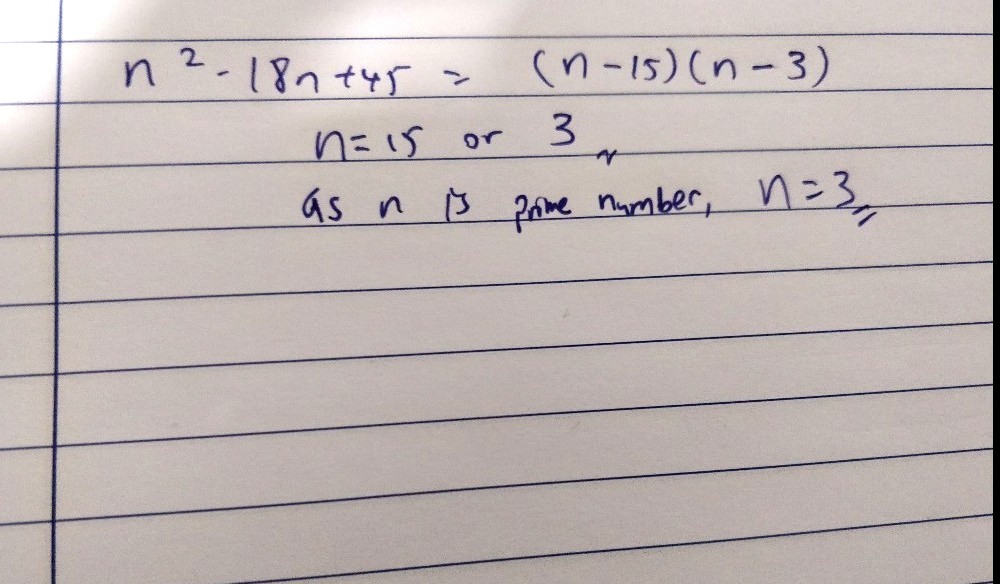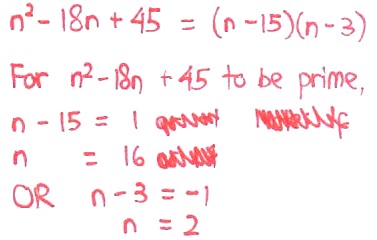Ask Singapore Homework?
Upload a photo of a Singapore homework and someone will email you the solution for free.

See 2 Answers
done
{{ upvoteCount }} Upvotes
clear
{{ downvoteCount * -1 }} Downvotes
Hope it helps you
Date Posted:
5 years ago
n = 3 gets you n2 - 18n + 45 = 0, and 0 is not a prime number.
The question is not asking for n to be a prime number. The question is asking for n for which n2 - 18n + 45 is a prime number.
The question is not asking for n to be a prime number. The question is asking for n for which n2 - 18n + 45 is a prime number.
Comprehended the question wrongly. Thanks for the correction!
done
{{ upvoteCount }} Upvotes
clear
{{ downvoteCount * -1 }} Downvotes
First, we factorise the expression using cross-factorisation. I am not sure if you have learnt this yet though.
Factorising the expression yields (n - 15) (n - 3).
Now, (n - 15) represents a number; so does (n - 3), so (n - 15) (n - 3) is just simply the product of two numbers.
A prime number is a positive integer which can be divided by 1 and itself (the definition does not include 1 as a prime number).
For the product (n - 15) (n - 3) to be a prime number, either of the numbers must equal to 1 (or -1 in some cases). It's alright for one of the numbers in the bracket to be -1, so long as the other number also has a negative sign (so that the product of two negative numbers is a positive number). However, obtaining 1 or -1 does not automatically mean that multiplication with the other number yields a prime number, so we must check accordingly.
Setting (n - 15) = 1, we get n = 16. This gets us (n - 3) = 13, and 1 x 13 = 13 is a prime number. So, n can be 16..
Setting (n - 15) = -1, we get n = 14. However, this gets us (n - 3) = 11, and (-1) x 11 = -11 is not counted as a prime number. So, n cannot be 14.
Setting (n - 3) = 1, we get n = 4. However, this gets us (n - 15) = -11, and 1 x (-11) = -11 is not counted as a prime number. So, n cannot be 4.
Setting (n - 3) = -1, we get n = 2. This gets us (n - 15) = -13, and (-1) x (-13) = 13 is a prime number. So, n can be 2.
All other values of n will not get you a prime number.
Hence, n can be 2 or 16.
Factorising the expression yields (n - 15) (n - 3).
Now, (n - 15) represents a number; so does (n - 3), so (n - 15) (n - 3) is just simply the product of two numbers.
A prime number is a positive integer which can be divided by 1 and itself (the definition does not include 1 as a prime number).
For the product (n - 15) (n - 3) to be a prime number, either of the numbers must equal to 1 (or -1 in some cases). It's alright for one of the numbers in the bracket to be -1, so long as the other number also has a negative sign (so that the product of two negative numbers is a positive number). However, obtaining 1 or -1 does not automatically mean that multiplication with the other number yields a prime number, so we must check accordingly.
Setting (n - 15) = 1, we get n = 16. This gets us (n - 3) = 13, and 1 x 13 = 13 is a prime number. So, n can be 16..
Setting (n - 15) = -1, we get n = 14. However, this gets us (n - 3) = 11, and (-1) x 11 = -11 is not counted as a prime number. So, n cannot be 14.
Setting (n - 3) = 1, we get n = 4. However, this gets us (n - 15) = -11, and 1 x (-11) = -11 is not counted as a prime number. So, n cannot be 4.
Setting (n - 3) = -1, we get n = 2. This gets us (n - 15) = -13, and (-1) x (-13) = 13 is a prime number. So, n can be 2.
All other values of n will not get you a prime number.
Hence, n can be 2 or 16.
Date Posted:
5 years ago
Thank you for the very clear and helpful explanation!







